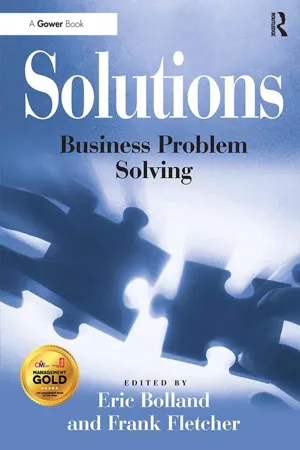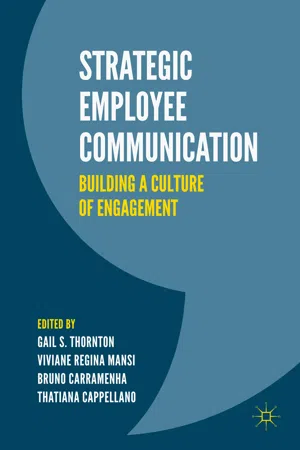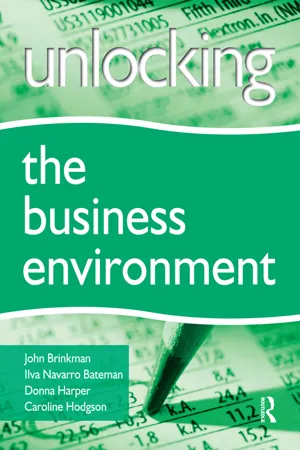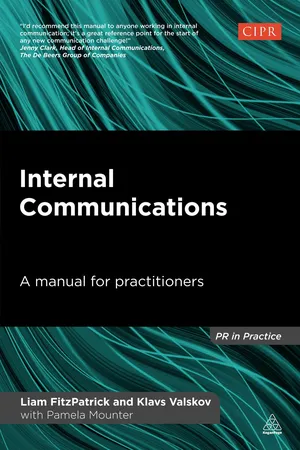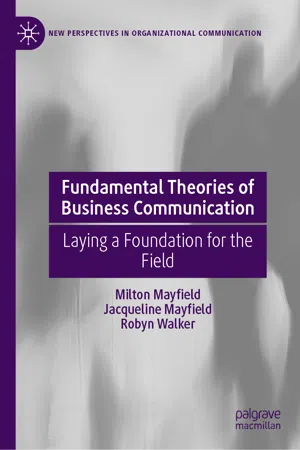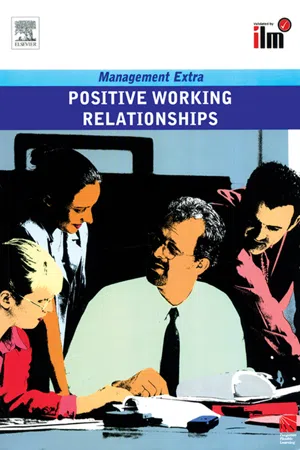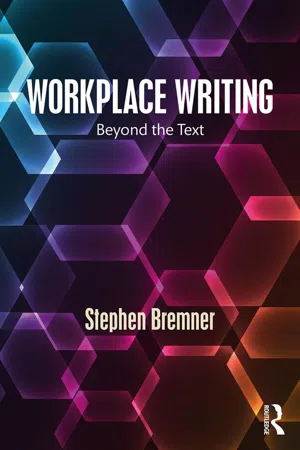Business
Communication Channels
Communication channels refer to the various methods through which information is transmitted within an organization. These channels can include face-to-face interactions, emails, phone calls, video conferences, and written documents. Effective management of communication channels is crucial for ensuring that information flows smoothly and efficiently throughout the business, ultimately contributing to improved productivity and collaboration.
Written by Perlego with AI-assistance
Related key terms
Related key terms
1 of 4
Related key terms
1 of 3
10 Key excerpts on "Communication Channels"
- eBook - ePub
Solutions
Business Problem Solving
- Frank Fletcher, Eric Bolland, Eric Bolland(Authors)
- 2016(Publication Date)
- Routledge(Publisher)
Non-verbal communication is an important part of both written and verbal communication and it can be considered a communication medium in its own right. Body language, posture, eye contact, and facial expressions clue receivers to the subconscious thoughts of the sender. For example, managers who use good posture, appear relaxed but confident, make good eye contact, and smile occasionally, appear to be authoritative and sincere.It is important for written, verbal and nonverbal messages to be consistent and harmonious. Listening to a concert with one of the choir members singing off key detracts from the experience. Similarly, the message can get lost if the sender’s written, verbal, and nonverbal signals are dissonant. For example, if the sales manager’s written message introduces a new service line, but his voice and nonverbal communication suggests doubt about its potential, the sales force may come away from the meeting less than motivated. The resulting impact of incongruent messages may be disastrous for the company.What are the channels of business communication?
Business messages are distributed through communications channels or media. Development of information technologies in recent years has given managers more channel options than ever before. Channels have unique characteristics that meet specific communications needs. For example, interpersonal communication offers more opportunities for face-to-face exchange, while web-based channels allow communication en masse—with potentially millions of people all over the world. Selection of appropriate channels is driven by the purpose of the communication and the size and needs of the organization.Face-to-face interactions provide the best channels for interpersonal communications. These types of interactions may be one-to-one, in small or large group settings, via the telephone, or over the Internet in the form of video-conferencing. Effective interpersonal communications are best achieved in one-to-one or small group settings. Factors that determine the platform for interpersonal communication include purpose of the communication, location of the target audience, time, convenience and budget, many of the same factors described above by Clampitt. Face-to-face communication includes public speaking and in-person presentations. Written, verbal and nonverbal messages may be exchanged via interpersonal communication. - eBook - ePub
Strategic Employee Communication
Building a Culture of Engagement
- Gail S. Thornton, Viviane Regina Mansi, Bruno Carramenha, Thatiana Cappellano, Gail S. Thornton, Viviane Regina Mansi, Bruno Carramenha, Thatiana Cappellano(Authors)
- 2018(Publication Date)
- Palgrave Macmillan(Publisher)
dialogue , and make employees feel like they are part of the organization, as well as inform them on the main messages the company wishes to convey.Formal communications may be carried out through print, digital, and face-to-face channels . Moreover, there are also informal communications , which manifests on the dialogue between employees themselves.Employee Communications Channels and Their Uses
There are many different kinds of communication channels available. According to the report Internal Communications Trends Survey (Aberje, 2017), conducted by the Brazilian Association of Business Communications , there is an interesting evolution of face-to-face communications over time, both with leadership and colleagues alike. This format has been steadily gaining on importance. Survey results also show that, of all communication channels evaluated, the most relevant were from the topleadership(97%) and direct leader (96%) . Colleagues now also play a significant role in comparison with official communication channels , a positive development , with 91% assigning high importance to communications by Colleague Multiplicators .On par with the trends in collaborative networks, digital channels also play a significant role. E-mail (93%) and intranet (84%) remain the most expressive channels . However, the biggest rollouts currently being planned are apps (30%) and internal social networks (23%). The main issue in this case is the connection between different channels and their individual roles. According to the trends brought to light by this survey, intranets will become the go-to hub for all information and knowledge. Additionally, e-mails will be used for official memos and social networks to enable collaboration.Regarding print communication channels , bulletin boards are still going strong, with 61% of companies boasting one, as opposed to 48% that have virtual bulletin boards - eBook - ePub
- John Brinkman(Author)
- 2014(Publication Date)
- Routledge(Publisher)
same level in the hierarchy of the team/department/organisation is referred to as horizontal communication, in that these people are deemed, or perceive themselves to be on the same level. This kind of communication is more likely to be two-way, as communicators tend not to have any degree of authority over each other. Diagonal communication cuts across hierarchical levels and functional work areas.Channels/methods of communicationAs we have seen, people tend to communicate with the same people in fairly predictable patterns. We shall now go on to consider how people undertake their communication, i.e. what channels/methods they use.There are so many ways that you can communicate with someone. A basic approach is to view communication as being either verbal (which includes oral and written communication) or non-verbal. Of course, oral and non-verbal communication such as body language occurs at the same time (except where you cannot see the person with whom you are talking, for example, over the telephone). New technology has also enabled new forms of communication to be possible, e.g. video conferencing, teleconferencing, and email.Every channel/method of communication will have its pros and cons, and each one varies in its information richness.Table 5.1 , On pages 104–105, provides an overview of a range of typical Communication Channels/methods encountered in the organisational context, and some of their associated pros and cons.Table 5.1 Communication Channels/methods, and some of their pros and consKey TermsCommunication Channels differ in their capacity to convey information, and this is referred to as their level of richness. Some methods of communication are regarded as richer than others, in that they have the ability to:•handle multiple cues, e.g. aural and visual, simultaneously•facilitate rapid feedback and•be very personal.Methods of communication are typically placed along a continuum of low-channel richness to high-channel richness. Richer forms are more likely to help ensure that a shared meaning occurs as a result of the communication.Figure 5.4 Information richness of some forms of business communication (Robbins, S.P. (2005) Organizational Behaviour. 11th edn. Harlow: Pearson)ActivityImagine that you work as a middle manager for an organisation. Your line manager has tasked you with exploring why the organisation has problems recruiting and retaining new staff. She has left it up to you how you can report back on your findings and recommendations. Identify how you would report back, and why - eBook - ePub
Internal Communications
A Manual for Practitioners
- Liam FitzPatrick, Klavs Valskov(Authors)
- 2014(Publication Date)
- Kogan Page(Publisher)
Second, people expect to hear certain things in certain ways. They don’t expect the CEO to be e-mailing them about the issue of car park passes and they wouldn’t expect the safety newsletter to talk about the next social event. If you only have one channel, communications becomes an undifferentiated wall of noise that is likely to be ignored.Third, different audiences will want to receive things in different ways as Chapter 4 on audiences and Chapter 5 on messaging make clear. The teacher will respond to one type of message, the engineer to another, and their responses will, in part, be conditioned by the channels chosen.So as we said earlier when we talked about Bill Quirke’s ideas, different channels have different impacts. Some are useful just for telling people things while others offer the opportunity for interaction and debate. When you want to give people a chance to understand something, a poster that simply raises awareness isn’t enough. When you want to translate a corporate message into a local action plan a team discussion might be more effective than an all-staff meeting.Channels don’t have fixed uses: how you use them matters. For example, posters can be a simple channel of awareness raising or, as we know from the advertising or political worlds, images can be unsettling or challenging. The intranet can be an online library or it can be a hub of debate. A team meeting can be the quickest way to induce sleep or an opportunity to excite and enthuse people about quite complicated subjects.The important thing is to understand what you need your channels to do for you and then develop approaches that will do the job that needs doing.To help you think about the media you need at your disposal, you may find it useful to consider general uses that you need to fulfil with your communications. Broadly, these might fall into the categories of Push, Pull, Talk, Community, Engage and Intelligence. We will explore these now, while stressing that channels can fulfil different purposes and the purpose a channel serves is not fixed: it will depend in part on how you choose to use it.Push channelsEvery organization needs the facility to broadcast information to employees. At its most basic we need a system for warning people that there is a fire, alerting colleagues to changes of rules or announcing events. Channels that deliver a one-way flow of information are often called ‘push’ channels because they send information out. The recipient is a passive actor, doing nothing on the receiving end. - eBook - ePub
Fundamental Theories of Business Communication
Laying a Foundation for the Field
- Milton Mayfield, Jacqueline Mayfield, Robyn Walker(Authors)
- 2020(Publication Date)
- Palgrave Macmillan(Publisher)
© The Author(s) 2020 M. Mayfield et al. Fundamental Theories of Business Communication New Perspectives in Organizational Communication https://doi.org/10.1007/978-3-030-57741-4_5Begin Abstract5. Channels and Barriers
Milton Mayfield 1 ,Jacqueline Mayfield1andRobyn Walker 2(1) Texas A&M International University, Laredo, TX, USA(2) Marshall School of Business, University of Southern California, Los Angeles, CA, USAKeywords Barriers Business communication Channels Descriptions TheoryEnd AbstractSomething there is that doesn’t love a wall —Robert Frost, Mending WallChapter Theories
- Business English as a Lingua Franca
- Communication Apprehension
- Communication Competence
- Genderlect Theory
- Information Theories
- Media Naturalness
- Media Richness Theory
- Media Synchronicity Theory
- Multimodality
- Social Presence Theory
- Source Credibility
- Uncertainty Reduction/Initial Interaction Theory
We should value clear messages in any business communication. By clarity, we mean transparency, or “sharing [all] genuine information that is relevant to an employee’s work in a timely manner” (J. Mayfield & Mayfield, 2018c , p. 52). Transparency leads to increased engagement, workplace trust, organizational commitment, and perceived leader effectiveness (Holmes & Parker, 2017 ; J. Mayfield & Mayfield, 2018c ; Norman, Avolio, & Luthans, 2010 ). Just as important, clear business communication matters because it is ethical. We will discuss this impact in more detail later in this introduction.Theories in this category reap the advantages of transparency by giving us the tools to understand and examine the barriers to clear communication and the channels through which communication (clear or not) travels. Plus, these same theories explore the bedrock requirements of communication—how to send a message. If a sender has no channel to send a message through or if barriers prevent someone from receiving the intended message’s meaning, then no communication can occur. These theories also grow our awareness of how communication travels through diverse channels, how these channels affect a message’s reception, and what barriers a message can encounter during transmission. - eBook - ePub
- Lazenby JAA(Author)
- 2020(Publication Date)
- Van Schaik Publishers(Publisher)
Organisational communication is essential for creating and maintaining a competitive advantage. Without communication in the organisation, it is difficult to understand what an organisation stands for, why it exists, who its customers are, how work is completed, who has authority over others and so on. The mission statement of an organisation clearly conveys the message of who its customers are, what products or services the organisation is providing and how it will be done. There are formal and informal Communication Channels in any organisation.12.5.1 Formal communication
Formal communication involves the formal Communication Channels in an organisation. Formal communication takes place via the prescribed organisational work arrangements. If a manager asks an employee to complete a certain task, he or she is communicating formally and uses the communication channel of the organisation. Formal communication can move vertically, horizontally and diagonally in an organisation.12.5.1.1 Vertical communication
Vertical communication flows downward or upward in an organisation:- Downward communication moves from superiors to subordinates and usually consists of orders or updates. It is used to inform, direct, coordinate and evaluate the employees in the organisation. A typical example will be if the CEO sends out an email to all his middle managers to inform them that the negotiated salary adjustment for the following year will only be 6.5% and not 8.5% as originally requested by the unions.
- Upward communication is information that moves from lower-level employees to their superiors and usually consists of feedback or reports. Upward communication facilitates employee involvement, shared decision-making and the building of positive working relationships between managers and their employees. For example, employees may be asked for their input during the budgeting process.
12.5.1.2 Horizontal communication
Horizontal or lateral communication is information that flows from worker to worker or manager to manager on the same hierarchical level and usually consists of reports or data. When a co-worker informs his or her colleague about an upcoming marketing event, horizontal communication is taking place. - eBook - ePub
- Elearn(Author)
- 2009(Publication Date)
- Routledge(Publisher)
Communication in organisations is full of contradictions. On the one hand, everyone agrees that it is vitally important – the lifeblood of the organisation. As early as 1916, Henri Fayol, the French engineer, put communication at the centre of his ‘wheel of management activities’. Ask any group of employees what matters most to them and you will almost certainly find ‘good communication’ high on the list.On the other hand, communication is one of the things that organisations most often get wrong. Charles Handy, in Understanding Organisations (1993), gives a list of studies showing how often communication fails to get through. Here are just two examples:Communication isone of the things thatorganisations mostoften get wrong. A study of communication in companies found that information communicated by top management was only remembered by one in five people on the shop floor- In another case study, while 95 per cent of supervisors felt they understood the problems of the people in their teams well, just 35 per cent of their team members agreed.
In their book Understanding Information (1990), Jonathon Liebenau and James Backhouse define communication as follows:Communication is a process which involves at least two parties. This process can be characterised as a set of activities involving a sender with intentions to convey, a medium or channel for carrying signals, and a receiver who has the ability to interpret those signals.Source: Liebenau and Backhouse (1990)Within this broad definition it is important to distinguish between:- spoken and written communication
- verbal and non-verbal communication
- formal and informal communication.
Spoken and written communication
The first key distinction is between spoken communication – where we speak and listen – and written communication – where we write and read. As Stephen Covey comments, managers spend many hours a day speaking, listening, reading and writing:The ability to do them well is absolutely critical to your effectiveness.Source: Covey (1992)Covey highlights the skills of listening as especially important. He points out that we all spend a lot of time at school learning to read, write and speak, but much less learning to listen and in practice it is listening skills that can be especially important to managers. - eBook - ePub
Using Communication Theory
An Introduction to Planned Communication
- Sven Windahl, Benno Signitzer, Jean T Olson(Authors)
- 2008(Publication Date)
- SAGE Publications Ltd(Publisher)
It is very important in many cases for the audience to know who is communicating with them. Too often communication is rejected because of an unclear perception of who is sending it; this can cause the audience to question the authenticity and legitimacy of the message. The complexity of today’s communication industry, with its new roles and shifting combinations of different sender roles, will confuse audiences further and make them less willing to listen. (Just as social psychologists refer to ‘the generalized other’ to denote people’s composite picture of significant people in their social environment, so we might use the term ‘the generalized sender’ to denote the vague picture the individual in today’s information society constructs to represent ‘those out there trying to communicate with me.’) It is the task of the communication planner to make it clear to the audience who actually is communicating with them and in whose interests. This objective points out the danger of using pseudo-communicators: if they are not carefully chosen, the impact of the message that pseudo-communicators convey may backfire, for example, if they are perceived as representing groups or interests other than those intended.For example, a traffic safety campaign launched by several semi-private organizations under the umbrella of and partly financed by the Federal Ministry of Transportation may come under attack from some opposition parties who charge that the campaign is actually designed as an image-boosting device to enhance the minister’s chances in the upcoming elections. The sincerity of the motives may be called into question.Medium and Channel
‘Medium’ and ‘channel’ often are used interchangeably, although several communication scientists distinguish between the two concepts. ‘Channel’ denotes ‘the physical means of carrying the signal’ (O’Sullivan et al. 1983: 31–2). It has little to do with meaning, but rather refers to the capacity to carry information. A ‘medium’ is ‘an intermediate agency that enables communication to take place’ (ibid.: 134) through the use of one or more channels. Usually the term is used synonymously with ‘mass media’ – reflecting, perhaps, a communication society that too often forgets that human beings also take on the role of medium.There are communication situations where it is important for the communication planner to define the channels and media available. This enables planners to assess better what resources they have at their disposal. In a health campaign, for example, the channels-to-hand to convey a message in a hospital would include the loudspeaker system, staff meetings, employee newsletters, closed circuit television, and so on; the hospital itself would be regarded as the medium.Message and Content
What is transmitted in the communication process is called the message - eBook - ePub
Exploring Internal Communication
Towards Informed Employee Voice
- Kevin Ruck, Kevin Ruck(Authors)
- 2019(Publication Date)
- Routledge(Publisher)
18 This approach emphasizes the knowledge-building process that modifies the way an individual assesses media richness. Four processes are highlighted:- Experience with the channel
- Experience with the subject
- Experience with the communication partner
- Experience with the organisational context.19
Indeed, it can be concluded that ‘the richness of a communication media is constructed socially and is related mainly to experience with the media and with the communication partner’.16 This social context may be one way of understanding why the successful adoption of internal digital platforms inside organisations remains relatively low. According the Gatehouse State of the Sector 2018 Report,20 advanced usage of social media (defined as ‘a number of social channels are already in place and they are being used by a large proportion of employees’) has remained stagnant at between 10 and 18 percent from 2013 to date. In the State of the Sector 2019 report,21 less than 50 percent of respondents agreed that ‘social channels are an integral part of our internal communication channel framework’. The same report highlights intranet and email announcements (two ‘old’ technologies) as the most used digital channels. A more detailed exploration of the digital workplace is provided in Chapters 15 –17.Qvortrup rejects the more deterministic elements of medium and richness theories, arguing that the Internet requires a different perspective, one based more around complexity theory.22 From this perspective, communication cannot be considered as a transfer process, but as a phenomenon with low probability. Furthermore, communication is not ‘natural’; it is highly improbable, and the effect of communication media is to limit the improbability of communication success. Dennis et al. argue that media richness theory is not convincing for computer-mediated communication and it does not consider how managers choose media.23 - eBook - ePub
Workplace Writing
Beyond the Text
- Stephen Bremner(Author)
- 2017(Publication Date)
- Routledge(Publisher)
7 CHANNELS OF COMMUNICATION IntroductionIt is a truism to point out the dramatic way in which communication has changed over the last twenty years or so, as opportunities opened up by technology in general and the internet more particularly – “the subject of much breathless contemplation” (Goodman and Hirsch, 2014, p. 130) – provide a vast and ever-increasing range of channels with which to communicate. The so-called ‘new’ technologies are developing at great speed, to the extent that it is not clear at what point any given means of communication might be no longer considered new – at the time of writing, for example, the book New New Media (Levinson, 2009) was already in its second edition. Moreover, it is quite probable, given the rapid pace of development in information and communications technology (ICT), that many of the channels and platforms that are currently modish may have fallen out of favour or been superseded by the time this book appears in print. (Note: In this chapter I have used a number of terms to talk about communication that is mediated through electronic channels, and these are intended as interchangeable, rather than representing different, nuanced forms of communication.)From the perspective of those engaged in workplace writing, the story is much the same, with increasing reliance on digital discourses seen in the workplace and writing more generally (Hafner, forthcoming) deftly summed up by Warschauer, Zhang and Park (2013, p. 825): “there is little serious writing that is not done digitally”. Certainly, a huge range of electronic options is at the disposal of the workplace writer that goes beyond well-established channels such as email and instant messaging (IM), and includes a variety of social media, various platforms for the collaborative production of texts, blogs and group decision support systems, to mention but a few.
Index pages curate the most relevant extracts from our library of academic textbooks. They’ve been created using an in-house natural language model (NLM), each adding context and meaning to key research topics.
Explore more topic indexes
Explore more topic indexes
1 of 6
Explore more topic indexes
1 of 4
